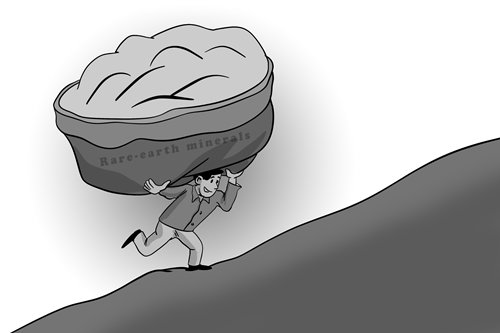HOME >> BUSINESS
How to transform China’s rare-earth resources into strategic advantages
By Zhou Chengxiong Source:Global Times Published: 2019/5/20 21:38:40

Illustration: Luo Xuan/GT
Rare-earth minerals are key elements required for many functional materials in modern high-tech fields, earning them the nickname "Vitamins of Modern Industry." The rare-earth sector is a hot industry in China, which has become a focus of public opinion amid tensions between China and other developed countries like the US.
The reason China's rare-earth industry and relevant policies often trigger controversy is mainly because China's rare-earth reserves account for roughly 30 percent of the world's total reserves, and the country produces more than 80 percent of the world's supply. Adjustments made by China to its rare-earth exports often face opposition from other countries, while the domestic public believes that the policies are not strong enough, and that with no pricing power over rare-earth products, China sells its natural resources too cheaply. In fact, most of the controversy stems from the lack of understanding of the current situation in the rare-earth industry.
First of all, it is necessary to have an accurate understanding of the rare-earth industry. In fact, some Western countries like the US also have rare-earth mines, but due to high mining costs, rare-earth mining is not profitable. Most of the rare-earth mines in other countries stopped operation after China started to export rare earths in quantity during the past century. Nevertheless, due to China's control of rare-earth mining and exports in recent years, the rare-earth prices have been on the rise, and some countries have resumed mining rare earths. Therefore, although rare earths are of high strategic value, they are not a particularly scarce resource. Using rare-earth production as a strategic chip would only generate short-term effects. Meanwhile, China is also the largest consumer of rare-earth products, and thus a rapid rise in rare-earth prices would be disadvantageous for the development of some downstream industries in China.
Second, we must have a clear idea of which aspects of China's rare-earth industry need to be strengthened. Mastering the production of raw materials is an advantage in the competition for modern industries, but the core competitive advantages are usually technical patents that are irreplaceable and have high barriers. In this sense, further improvement is required in China's rare-earth patents. In 2017, more than 680,000 patent applications related to rare earths were filed worldwide, with China's accounting for only 18 percent. Moreover, in terms of core patents, China still lags far behind developed countries. For instance, the rare earths China consumes the most are rare-earth permanent magnet materials, the core patents of which are all in the hands of Japanese and US companies. Therefore, while China is a large producer and consumer of rare earths, technically speaking, it is not strong in rare earths.
Of course, after decades of development, China's rare-earth industry has accumulated a certain technological strength, with considerable progress seen in production levels. With a strong say in the rare-earth industry, China's rare-earth policy also has a strong influence on the international market. However, with the increase of rare-earth mining in other countries, China's influence in the industry is facing new challenges, and thus the country needs to make preparations in the following respects.
China needs to increase investment in technological research and development of high-end rare-earth products and establish a patent alliance. The resource tax revenue collected from rare-earth mining should be mainly invested in the research and development of high-end rare-earth products to seize the technological upper hand in the industry. There is no future in taking the old path of grabbing market share through low prices. Relevant companies and scientific research institutions should be organized to form a rare-earth technology patent alliance. If necessary, China should also acquire some foreign core patents to raise the technical barriers of rare-earth products.
Second, the country needs to establish a database for accurate classification and management of rare-earth products, and set up an environmental resource cost adjustment mechanism. There are many kinds of rare-earth elements and complicated categories of such products. Therefore, when it comes to the formulation of industrial policies, it is not feasible to adopt a one-size-fits-all approach. The precondition for precise policies is to accurately grasp the industrial conditions, which must be based on a database for precise classification and management of rare-earth products. In addition, one of the main reasons behind the low prices of rare-earth products in China is the low costs of environmental resources, which must be elevated.
Third, China should establish a rare-earth resource reserve mechanism, and form an international alliance for rare-earth resources. It is necessary to establish a resource reserve mechanism for rare-earth materials that China has dominant reserves of or will be short of, so as to cope with changes in domestic and global markets. In the meantime, it is necessary to form an international alliance of rare-earth resources with member countries under the Belt and Road Initiative. By using its comparative advantages in capital and technology, China could make some adequate purchases of rare-earth resources or jointly establish rare-earth processing companies.
The author is deputy director of Consultation and Research Center for Strategic Issues at the Chinese Academy of Sciences. bizopinion@globaltimes.com.cn
Posted in: EXPERT ASSESSMENT